Rahul Mehrotra and Filipe Vera
Niyogi Books, 2015

Kumbh Mela, a Hindu religious megafair (or mela) occurs at the confluence of the Ganga and Yamuna Rivers in India once every 12 years. It is the largest public gathering in the world and draws tens of millions of pilgrims over the course of 10 weeks (most recently January 14 to March 10, 2013). A group of over fifty Harvard University researchers, students, staff members, and doctors from five different disciplines (public health, design, business, arts and sciences, and divinity) engaged in a multiyear project titled Mapping the Kumbh to document and understand the process by which this megaevent is planned, implemented, and then dismantled. The resulting book, Kumbh Mela: Mapping the Ephemeral Megacity, presents the cross-disciplinary work of this research group. Most scholarship on the Kumbh Mela can be categorized as coffee table books, photojournalism websites, TV programs, analyses that examine religious sites and pilgrimage from an anthropological and/or religious studies perspective, religious tourism, and the public health consequences of the Kumbh Mela.1Exceptions to this includes K. Maclean’s study of the power dimensions of the Mela, and J. G. Lochtefeld’s study of the public performance feature and power structures evident in the Mela.2What sets apart this present book is its breadth and interdisciplinary focus: it includes photo-essays in the likeness of coffee table books, chapters that examine public health issues related to the Kumbh Mela as well as governance structures, and specifically spatial systems that characterize this megaevent.
The book begins with a preamble and is then organized into six sections. The first section, “Purpose,” consists of a single chapter—“Understanding the Kumbh Mela,” by Diane Eck and Kalpesh Bhatt—that provides the background for the Kumbh Mela, from the spiritual meaning of the Mela to its geographical location and its historical context.
“Urbanism,” the second section, consists of two chapters: “The Ephemeral Megacity, by Rahul Mehrotra and Felipe Vera; and “Setting the Megacity Vignette,” by James Whitten, Oscar Malaspina, and Vineet Diwadkar. In “The Ephemeral Megacity” the authors review the process and the physical and social infrastructural elements that come together to create the temporary city. They question the city as a stable entity and argue that, to be sustainable, present day cities should be flexible and responsive to flows of people and material. “Setting the Megacity Vignette” focuses on how the monsoon and a flexible urban grid interact at different scales to create the Kumbh Mela city. It consists of several detailed maps and diagrammatic analysis, many of which are difficult to follow.
The third section, “During the Kumbh Mela: January 14 to March 22,” consists of four chapters. It begins with a wonderful photo-essay—“During the Kumbh Meka Photo-Essay, by Dinesh Mehta—that allows the reader to experience the different facets of the event. The next chapter, “Health and Safety at the Kumbh Mela,” by Satchit Balsari and Jennifer Leaning, details public health planning for the event and makes the point that the human system at the Kumbh Mela is not as facile as the physical infrastructure system. This is followed by “Maximum Load Vignette,” by Chuan Hao Chen, which offers a parametric analysis of the pop-up city. (However, this essay provides little evidence of algorithmic design or analysis so one is left wondering what made the analysis parametric.) The concluding chapter, “Investigating Population Dynamics of the Kumbh Mela through the Lens of Cell Phone Data,” by Jukka-Pekka Onnela and Tarun Khanna, examines the population dynamics of the mela through cell phone data. It provides an excellent overview of preliminary findings, purpose, and methodology, and direction for future research.
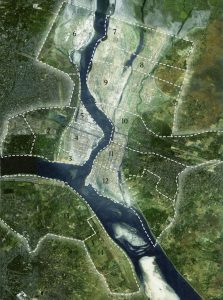
“Deployment and Deconstruction,” the fourth section, is bookended by the photo-essays “Deployment” and “Deconstruction,” both by Dinesh Mehta, with a chapter on maps (“Deployment Maps,” by Michael Lee and Juan Pablo Corral) and physical infrastructure (“Physical Infrastructure Vignette,” by Jose Mayoral and Johannes Staudt) in between. Both photo-essays provide the reader with a vivid window into the process of assembling and disassembling the different systems that make up the Kumbh Mela. The chapter titled “Deployment Maps” presents paired sets of satellite and line-drawing maps of various systems (land cover, river flow, roads) through space and time, some of which are hard to decipher. “Physical Structure Vignette” does an excellent job of explaining, through the inventive use of diagramming, photographs, and maps, the different systems at the heart of the Kumbh Mela.

The fifth section, “Governance and Business,” consists of two chapters. The first chapter, “Government and the Minimalist Platform: Business at the Kumbh Mela,” by Tarun Khanna and John Macomber, discusses the Kumbh Mela’s leadership and organizational structure and identifies the features that led to the large event’s success. Tables help to clearly articulate the research agenda, research findings, and the minimalist intervention strategy of the government during the Kumbh Mela. The essay illustrates how, by matching ambition with capability, the government was able to pull off a successful venture with help from the private and not-for-profit sector. The second chapter, “Governance and Organizational Structures,” by Benjamin Scheerbarth, Alykhan Mohamed, and Vineet Diwadkar, presents the multilevel and dynamic governance structure of the Kumbh Mela. Through a set of diagrams, this chapter visually presents the nuanced workings of the many actors and organizations involved in the successful 2013 Kumbh Mela event.
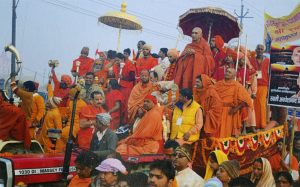
“Lessons,” the last section of this book, consists of two chapters. The first, “Learning from the Pop-Up Megacity: Reflections on Reversibility and Openness,” by Rahul Mehrotra and Felipe Vera, focuses on lessons learned from this megaevent, highlighting the need for flexible responses to the ever-changing flows of people, materials, and finance in postmodern cities. The lessons learned from this extensive case study are presented through the attributes of reversibility and openness. The authors point out that the distinguishing feature of the Kumbh Mela is both the feat of constructing a megacity in a short period of time and its disassembly at the end of the event. It is the disassembly, characterized as reversibility, that is key to the success of the Kumbh Mela. The authors propose that reversibility be understood in terms of both material and immaterial dimensions. The Kumbh Mela consists of four interrelated steps—planning, implementation, management, and deconstruction—that allow for the successful completion of the event. The use of a flexible, agile process and appropriate technology (namely low-tech methods that allow a large number of people to be involved in assembly/disassembly) is central to its success. The main lesson is that strategies for disassembling structures should be integral to the protocols for design/construction/management of our built environment. Openness focuses attention on the incomplete, unbalanced nature of city growth and regeneration in contemporary times and calls for considerations of systems thinking at multiple scales to allow for spontaneity, negotiation, and responses to shifting conditions. Ultimately, at its core, the Kumbh Mela is an exercise in place-making that is centered on human relations and activities.
The final section’s last chapter, “Individual Portraits,” by Giles Price, is composed of a series of portraits (without any captions) that allows the reader to respond to the users on a one-on-one basis. The wide range of people showcased (in terms of age, gender, occupation, socioeconomic status, and religious affiliations) conveys the diversity of the Kumbh Mela as a performative event.
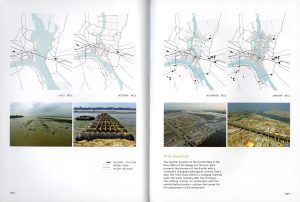
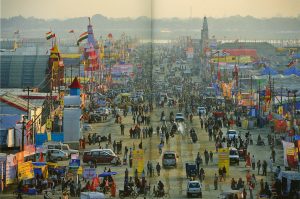
The editors and research team should be commended for tackling such an enormous project and highlighting the different dimensions of this undertaking. The mix of more traditional chapters, photo-essays, and vignettes, coupled with the liberal use of beautiful and information-packed figures, diagrams, and maps, makes this a wonderful book that transports readers to the look, feel, and texture of the Kumbh Mela. Given the interdisciplinary nature of this project, this book will appeal to a wide audience, from those curious to discover more about this megaevent to urban planning and urbanism scholars and public health administrators.
I would be remiss if I did not point out a few of the book’s shortcomings. The first concerns the drawings and diagrams interspersed generously throughout this book. These diagrams/maps are an integral part of this endeavor and distinguish it from other publications on this topic. The photo-essays provide a window into the world of the Kumbh Mela through specific lenses (for example, deployment), while the vignettes consist of a series of analytical diagrams/maps that help illustrate the different systems in use (like enclosure, infrastructure, crowd control) during the Kumbh Mela. However, many of the drawings and diagrams are unfortunately hard to read, especially in the vignettes. It seems that the need to communicate information to users was subservient to a design aesthetic. This is evident in the decision to not number the diagrams and figures, problematizing referencing these aids in the body text. Another shortcoming is that even though the authors state (in the preamble) that this interdisciplinary undertaking produced a rich set of teaching tools across several disciplines, no explicit teaching tools are presented in the book. The “Lessons” section of the book could have easily accommodated this information. Such teaching tools would have been helpful to other teams contemplating interdisciplinary projects of this type and scale.
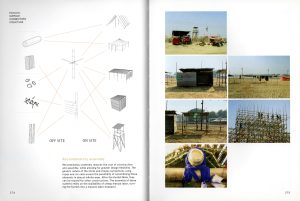
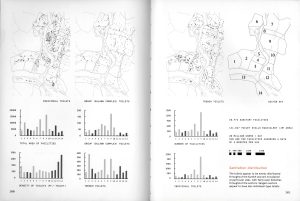
It was interesting to note the ways in which the different disciplines (public health, design, business) interfaced with the project. The “Health and Safety” chapter details the health-related processes at play during the Kumbh Mela. The team introduced real-time surveillance through the deployment of an “innovative disease surveillance tool,” which lead to the daily plotting of data. In other words, the research team collected primary data from people on the ground, which then informed their study. Similarly, the team working on population dynamics sought out secondary data from cell phones to inform their study of human behavior during the Kumbh Mela. In the case of the design professionals, a lot of data was presumably collected for analysis, but there was little discussion of how this data collection was planned and implemented. Much of the analysis focused on a level of abstraction that was one step removed from the ground and attentive to a systems-level understanding. While this was definitely needed, the chapters on the built environment would have benefited from the lived-experience accounts of different groups of Kumbh Mela visitors. Perhaps that can be the focus of future work on this recurring event.
Mallika Bose is associate professor of landscape architecture at Penn State University. Trained as an architect specializing in environment-behavior studies, she is interested in the how the built environment impacts behavior, especially for disadvantaged groups. She actively pursues research in the following areas: community-engaged design and planning; built environment and active living/healthy eating; gender and development; and design/planning pedagogy. She recently coedited a book on community-engaged teaching/scholarship titled Community Matters: Service-Learning in Engaged Design and Planning, which received the 2015 Great Places Book Award from the Environmental Design Research Association.

How to Cite this Article: Bose, Mallika. Review of Kumbh Mela: Mapping the Ephemeral Megacity, by Pahul Mehrotra and Filipe Vera. JAE Online. August 21, 2018. http://www.jaeonline.org/articles/reviews-books/kumbh-mela-mapping-ephemeral-megacity#/.






